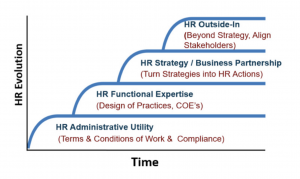Human Resource Management: An introduction
Learning Objectives
- Define HRM and explain its evolution over the years.
- Explain the role of HRM in organizations.
- Define, discuss and explain the major HRM activities.
- Explain the professional and personal skills needed to be successful in HRM.
- Understand the role of the Ontario HR professional – HRPA.
- Understand how the business context influences HRM.
Every organization, large or small, uses a variety of capital to make the business work. Capital includes cash, valuables, or goods used to generate income for a business. For example, a retail store uses registers and inventory, while a consulting firm may have proprietary software or buildings. No matter the industry, all companies have one thing in common: they must view people as intellectual capital. This will be our focus throughout the text: achieving organizational effectiveness through the use of people’s skills and abilities.
What Is HRM?
Human Resource Management (HRM) is an integrated set of processes, practices, programs, and systems in an organization that focuses on the effective deployment and development of its employees. These processes include employing people, training them, compensating them, developing policies relating to them, and developing strategies to retain them. It is, by most accounts, one of the most critical functions of an organization, because for an organization to be efficient, it needs employees and systems that support them. Think of an organization that you admire (you can use Fortune’s ranking of the World’s Most Admired companies and Canada’s Top 100 employers, an annual ranking). If you look closely at these companies, you’ll find that they are all built, without exception, around efficient, strong, and innovative HR processes.
HRM: A Short History
As a field, HRM has a long history. It takes root in the study of psychology, organizational behaviour, and industrial engineering. The field has undergone many changes over the last twenty years, giving it an even more important role in today’s organizations. In the past, human resource management (HRM) was called the personnel department. This department was in charge of hiring people and dealing with the paperwork related to employment. More recently, however, the personnel department has been divided into human resource management and human resource development, as these functions continue to evolve. More recently, HR departments often contain “people” and “culture” in their nomenclature in order to broaden the understanding of the organizational influence of HR. HRM is crucial to an organization’s success and serves a key support role in a company’s strategic planning because so many businesses today depend on people to support their vision and accomplish their mission.
Figure 1.1. Examples of Differences between Personnel Management and HRM
| Personnel Management Focus | HRM Focus |
|---|---|
| Administering of policies | Helping to design, implement and administer talent management policies |
| Stand-alone programs, such as training | HRM training programs that are integrated with company’s mission and values |
| Personnel department responsible for people administration | Partner with management in all areas of hiring and management of people |
| Creates a cost within an organization | Contributes to the profit objectives of the organization |
In the book HR From the Outside In (Ulrich, Younger, Brockbank, & Ulrich, 2012), the authors describe the evolution of HR work in four “waves”.1 (see Figure 1.2).
Early 1900s: Wave 1 focused on the administrative work of HR personnel, such as the terms and conditions of work, delivery of HR services, and regulatory compliance (e.g., payroll). This administrative side still exists in HR today, but it is often accomplished differently via technology and outsourcing solutions.
1970s: Wave 2 focused on the design of innovative HR practice areas, such as, compensation, learning, and sourcing. The HR professionals in these practice areas began to interact and share with each other to build a consistent approach to human resource management. The HR credibility in Wave 2 came from the delivery of “best-practice” HR solutions.
1990s: Wave 3 has focused on the integration of HR strategy with the overall business strategy. Human resources appropriately began to look at the business strategy to determine what HRM priorities to work on and how to best use resources. HR began to be a true partner to the business, and the credibility of HRM was dependent upon HR having a seat at the table when the business was having strategic discussions.
2000s: In Wave 4, HRM continues to be a partner to the business, but has also become a competitive practice for responding to external business conditions. Organizations get ahead of the competition with their HRM practices.
Although each “wave” of HRM’s evolution is important and must be managed effectively, it is the “outside in” perspective that allows the human resource management function to shine via the external reputation and successes of the organization.
Figure 1.2.

The Role of HRM in Organizations
HRM is an ‘umbrella’ term for many different and interrelated functions. It is necessary to point out at the very beginning of this text, that every manager has a role relating to human resource management. Just because we do not have the title of HR manager, it does not mean we won’t perform all or at least some of the HRM tasks. For example, most managers deal with the selection, compensation, and motivation of employees—making these aspects not only part of HRM but also part of management in general. Most experts agree on eight main roles that HRM plays in an organization. These roles are described in the following sections.
Legislation and Law
It is very important that human resource managers are aware of all the laws that affect the workplace and they ensure that the processes in place abide by them. An HRM manager will work under the following legal frameworks:
- Federal Government
- Provincial Government
- Health and Safety Requirements
- Labour Laws
- Employment Standards
The legal environment of HRM is always changing, therefore, HRM must always be aware of changes taking place and then communicate the changes to the entire management organization. In this textbook, we have decided to address these laws in each relevant chapter instead of presenting them in a single chapter.
Corporate Policies
In addition to having to comply with the requirements mandated by law, every organization may have their own set of unique policies. These policies can be set to ensure fairness (e.g., vacation policy above and beyond those legally mandated), to enhance effectiveness (e.g., internet usage policy), or simply to reinforce the culture (e.g., dress code). Some of the roles of HRM are to identify issues that can be addressed by implementing a policy; these can range from chronic tardiness of employees to a lack of decorum in meetings. HRM, management and executives are all involved in the process of developing policies. For example, the HRM professional will likely recognize the need for a new policy or a change of policy, they will then seek opinions on the policy, write the policy, and then communicate that policy to employees. The range of policies that can be designed is endless; here are a few examples of innovative policies that can be found in some companies, including giving time-off to employees to volunteer in community organizations (to promote well-being and group work) and eliminating job titles.
Job Analysis and Design
Organizations rely on the execution of numerous and varied tasks. These tasks, which are often carried by employees, have to be structured in such a way to maximize efficiency. They should be clear and distinct from each other. They should also be performed by capable employees. HRM supports the definition, documentation and organization of these tasks through the processes of job analysis and job design..
Talent Acquisition
You need the right people to perform tasks and get work done in the organization. Even with the most sophisticated machines, humans are still needed, therefore, one of the major tasks in HRM is talent acquisition.. Talent acquisition involves the entire hiring process from posting a job to negotiating a salary package. Within the talent acquisition function, there are four main steps:
- Talent Management Strategy
- Human Resource (Capital) Plan
- Recruitment Plan
- Selection Process
Training and Development
Once we have spent the time to hire new employees, we want to make sure they are trained to do the job and continue to grow and develop new skills. This results in higher productivity for the organization. Training is also a key component in employee motivation. Employees who feel they are developing their skills tend to be happier in their jobs, which results in an increase of employee performance, productivity and retention.. Examples of training courses and programs might include the following:
- Job skills training, such as how to use a computer program
- Training on communication
- Team-building activities
- Policy and legal training, such as sexual harassment training, safety training and ethics training
- Time management skills
Performance Assessment and Management
Employee performance is a support role provided by HRM to the organization and management. HR has the responsibility of designing, maintaining and administering an organization’s performance management policies and systems. Basically, people have to be good at what they do. In a coffee shop, baristas have to produce a great cup of coffee, within a certain amount of time, and serve it to the customer in a pleasant manner. Every job is different and quite complex when you think of the different ways in which performance is defined. It is the role of the HRM professional to devise systems to measure this performance with precision and use this information to help the employee and the organization. Performance appraisal systems may include:
- A 360 appraisal process
- A behaviour checklist
- A graphic rating scale
- MBO or management by objectives
- Annual employee performance appraisals
- Performance Improvement Plan (PIP)
However, assessing performance is only the beginning. Once a measure of performance is obtained, the HRM professional uses it for multiple purposes, including:
- Provide feedback for employees
- Determine compensation (e.g., bonus, raise, etc.)
- Take disciplinary measures
- Support career development
Compensation and Benefits Administration
HRM professionals need to determine that compensation is fair, meets industry standards, and is high enough to entice people to work for the organization. Compensation includes anything the employee receives for his or her work. In addition, HRM professionals need to make sure the pay is comparable to what other people performing similar jobs are being paid. This involves setting up pay systems that take into consideration the number of years with the organization, years of experience, education, and also considers the results of external salary surveys. e.g. Hays Canada.. Total compensation (package) may include the following:
- Pay
- Group Life and Health Insurance
- Retirement pension plans
- Stock grants and purchase plans
- Vacation time
- Sick leave and benefits
- Bonuses
- Tuition reimbursement
Labour Relations
A labour union, also called a trade union or worker’s union, is an organization that represents the collective interests of employees. HRM professionals are involved in the negotiation (collective bargaining) and management of union contracts. These contracts typically cover compensation, work schedules, benefits, discipline, and other work-related processes. Unions are very prevalent throughout Canada. As such, an understanding of labour unions is very important to be effective.
Health and Safety
 Safety is a major consideration in all organizations. Often times new laws are created with the goal of setting federal or provincial standards to ensure worker safety. Unions and union contracts can also impact the requirements regarding worker safety in the workplace. It is up to the Human Resource Manager to be aware of worker protection requirements and ensure the workplace is meeting federal, provincial, industry specific and union standards. Worker protection issues might include the following:
Safety is a major consideration in all organizations. Often times new laws are created with the goal of setting federal or provincial standards to ensure worker safety. Unions and union contracts can also impact the requirements regarding worker safety in the workplace. It is up to the Human Resource Manager to be aware of worker protection requirements and ensure the workplace is meeting federal, provincial, industry specific and union standards. Worker protection issues might include the following:
- Chemical hazards
- Heating and ventilation requirements
- Use of “no fragrance” zones
- Protection of private employee information
HR Analytics

Like every function in organizations, HRM has been drastically affected by technology. Today, a vast amount of information is collected about employees via Human Resource Information Systems (HRIS). This information, in turn, can be used to support management decisions using sophisticated analytical tools. For example, a financial institution can implement quarterly employee satisfaction surveys (ESAT) and investigate predictors of ‘dips’ and ‘jumps’ in satisfaction. It could uncover that those employees working on the investment side of the business tend to be very stressed during the preparation of end-of-quarter fund performance reporting. Knowing this, they could implement special communication efforts and improved processes or training for those employees during critical business cycles of the year. We take a closer look at this exciting and relatively new HR function in Chapter 11 “HR Analytics”.
HRM as an Integrated Set of Processes.
HRM relies upon a sophisticated set of integrated process to help the organization manage human capital. The effectiveness of HRM lies in how well integrated these processes are and how well aligned they are with the mission and strategy of the organization. For example, a new policy on workplace safety protocols will only be effective if employees are trained to understand and respect it. In addition, that policy has little chance of taking hold if it is not part of the performance appraisal process. Finally, in a unionized environment, any policy will have to be designed with the cooperation of the labour union so that it is integrated into the collective agreement.
References
Ulrich, D., Younger, J., Brockbank, W. and Ulrich, M. (2012), “HR talent and the new HR competencies”, Strategic HR Review, Vol. 11 No. 4, pp. 217-222.

